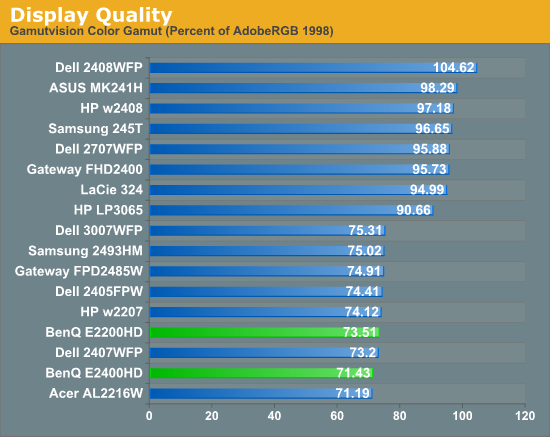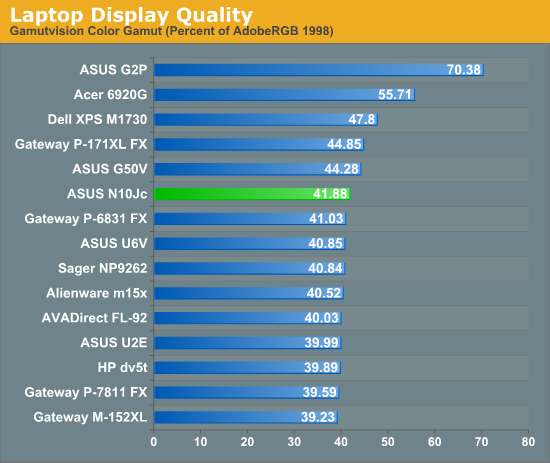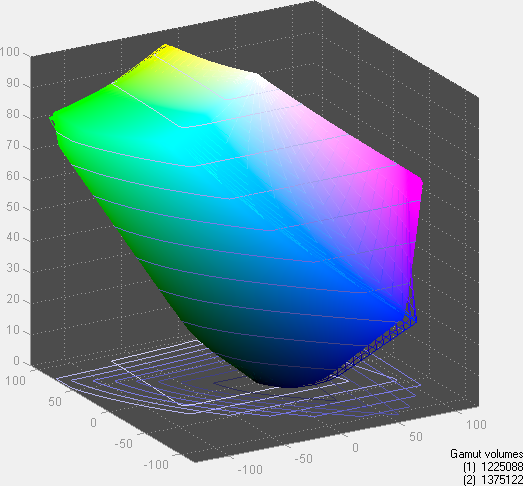Dell Studio XPS 16: Highest Color Gamut Ever?
by Jarred Walton on February 26, 2009 6:00 AM EST- Posted in
- Laptops
Okay, let's get something out of the way right off the bat: I started work on a review of the Dell studio XPS 16 before CES 2009. Originally intended to go live at CES, I decided to hold off in order to conduct additional testing and send some questions to Dell. Ultimately, we ran into some problems with the sample laptop, which is a prerelease version with a few kinks that need to be worked out. Ironically enough, the one major complaint in involves a glitch with the LCD on the unit we received, but we didn't notice this problem on any of the other studio XPS 16 laptops at the show. Anyway, I'm holding off on the full review until Dell can provide a retail sample, which should occur in the near future. In the meantime, one of the initial test results was shocking enough that I felt it was time for a blog. That's right: it's time to talk about laptop LCDs again!
When Dell claimed that the Studio XPS 16 would have the highest color gamut of any current laptop, I was a bit skeptical. I mean, the best color gamut I've seen up to now was on the ASUS G2P, which managed a rather impressive 70% of the Adobe RGB 1998 gamut. The next best LCD I've tested happens to be the Acer 6920G 1080P model, coming in around 55%. Everything else is roughly 45% or lower. On their own, such numbers don't necessarily mean a lot, so let's give a point of reference. Desktop LCDs from several years ago typically scored around 70% to 75% -- in other words the best laptop LCD I've tested to date might be able to match the entry-level desktop LCDs.
Here are a couple charts from the most recent reviews for laptops and LCDs showing how things stack up. To say that the laptop LCDs are uninspiring is a gross understatement.


As you might have guessed, the reason for this blog is that I was just putting together the results from the Dell Studio XPS 16. Given that it has a 16" LCD with a 1080P resolution, I assumed Dell was using the same LCD panel as the Acer 6920G. It's worth noting that there are two LCD models for the Studio XPS 16, so perhaps the less expensive version is the same as the Acer laptop. As for the more expensive LCD... well, have a look at the following color gamut chart (courtesy of Gamutvision).

It's not just that Dell has managed to close the gap with desktop LCDs; they have actually surpassed what many of the best desktop LCDs achieve! A color gamut of 112% of the Adobe RGB 1998 standard is extremely impressive. The "secret sauce" in this recipe for success is that Dell uses RGB LED backlighting instead of the standard white or yellow LEDs (or CCFLs) found in most LCDs. Obviously desktop LCDs have managed better color gamuts prior to now, but this is the first LED backlit LCD I've seen that actually manages to provide a good color gamut. That bodes well for the future of both desktop and laptop LCDs based on LED backlighting -- good colors and lower power requirements all in the same package.
Unfortunately, there are still some major gaps between desktop and laptop LCDs. The biggest one is the native panel technology; I still haven't managed to procure any laptops that use something other than a standard TN (twisted nematic) panel. That's entry-level desktop LCD technology, and while it's certainly cheaper, I prefer to spend the money on S-PVA, S-MVA, or S-IPS panels (in that order). Frankly, I would love to see any of those technologies utilized in a laptop LCD! (On a side note, if you get a desktop LCD and you plan to use it in portrait mode, you absolutely do not want a TN panel!) Panel technology also has a big influence on color quality, and so far none of the laptops I've tested come anywhere near what we see on a good desktop LCD. There are always spikes in delta E up to 5.0 or higher, and the Studio XPS 16 doesn't appear to change that.
Let's wrap things up with a little bit of polling, shall we? I have my opinions on how important a good LCD is when it comes time to purchase a new laptop, but I'm curious to hear your feelings on the subject. Let's not restrict things to just discussing LCD quality, though; I've put together several questions regarding LCDs. I'd love to hear your input, and if you have any other thoughts on the matter you can post below in the comments or drop me an e-mail.
{poll 121:1725}










91 Comments
View All Comments
valv - Thursday, February 26, 2009 - link
I think that most laptop users are like me. We use the laptop mainly for office work, or browsing the internet and in these uses, it doesnt matter what the colors are. (As long as there are colours)An in these uses I prefer 5:4 display, because it gives you more vertical space (better for text and documents than 16:9 or 16:10). For movies, 16:9 is naturally better, but i like to watch my movies from a bigger screen.. Way bigger.
djc208 - Thursday, February 26, 2009 - link
I have to agree, my little 14" laptop has a 16:9 screen and a lot of times you can barely get a youtube video to fit the window properly. You're always scroling up or down. For video content on the go it's fine (assuming the video content is 16:9, but otherwise I prefer my regular 19" CRT for text and web pages.strikeback03 - Friday, February 27, 2009 - link
I don't think YouTube videos are even 400 pixels tall.murphyslabrat - Thursday, February 26, 2009 - link
Actually, for reading, I prefer the wider screens. I find vertical scrolling much less annoying than having to scroll horizontally. I do do a lot of reading on my laptop, and I find that, most often, I am fitting documents to the width, rather than the height.JarredWalton - Thursday, February 26, 2009 - link
It's good to see I'm not alone in my thinking. So far, the tally is going overwhelmingly in favor of moderately sized laptop LCDs of a high quality, with a higher resolution than we typically see. Every time I get another 15.4" laptop with a 1280x800 LCD, I'm disappointed. I'd love to see more 1920x1200 options that aren't in 17" (or larger) notebooks. That was one of the best parts with the Alienware m15x - the other highlight being the ability to turn off the discrete GPU to conserve battery life.Okay, continue on... I'm off to bed!
minimal - Thursday, February 26, 2009 - link
I was considering the Dell Studio 16 until I realized you can only get the the LED screen in 1080p. My eye sight is perfect yet this is insanely small. It's an unfortunate trend that makes laptops that much more annoying to use.... just more hunched back computing on a small keyboard, even more microscopic text at awkward angles. 1280x800 is perfect on my current 15.4" laptop. I find anything over 1440 is excessive. Now the only other option on the Studio 16" is 1366x768 (not LED). So now they took away all that horizontal space to accommodate movie watching when all I need is to get work done. It's unfortunate that "entertainment" is driving laptop design when a lot of us would prefer 4:3 to get work done. I still remember my old ancient 15" Dell with a 1400x1050 resolution, I really miss that screen.Hrel - Saturday, February 28, 2009 - link
you do realize that 1366x768 provides more horizontal real estate than 1280x800. It's just slightly less vertical room, which is made up for by going from a 15" screen to a 16" screen. It would be nice if the lower res screen was RGB LED but at least it's LED so we get the battery life bennefits. I'm still waiting for a laptop that I can charge up, go out and use all day, and not have to charge up again till I go to bed. 12 hour minumum without batter degredation would be good, cause then I'd just need two batteries to make sure I could get through the whole day, or maybe just switch to an over-sized battery. I can dream, and in 5 years or so it will probably be true...JarredWalton - Sunday, March 1, 2009 - link
Just FYI, my testing to date has shown virtually no battery life advantages to having a lower resolution with the same screen size. It's tough to say for certain, but overall I think LCD size is the main item and the resolution is a negligible factor. LED backlighting with a higher res would certainly use less power than lower res CCFL.plewis00 - Friday, February 27, 2009 - link
The 1366 x 768 panel IS a LED-backlit, just not 'RGBLED'.Back to the article, but I think the reason we don't see anything other than TN screens is down to the considerably higher power consumption of the other technologies and that's a trade-off few people will want to make.
BikeDude - Thursday, February 26, 2009 - link
High resolution is great for pictures.MS have already done quite a bit in Vista to help high resolution display users, and there is more to come. Just zoom...